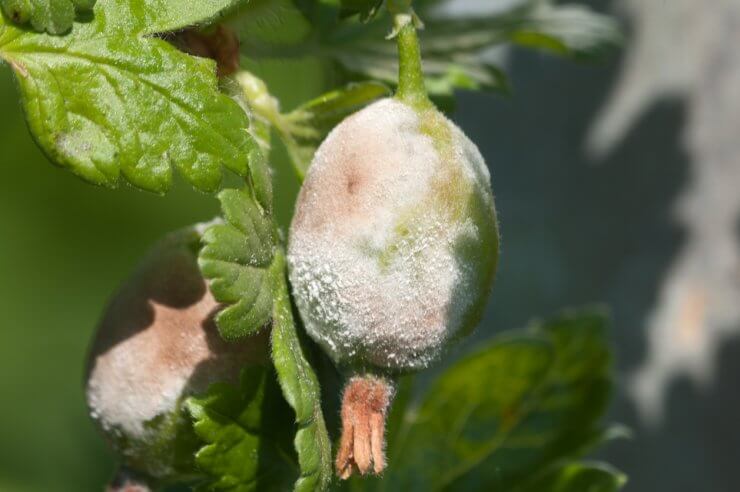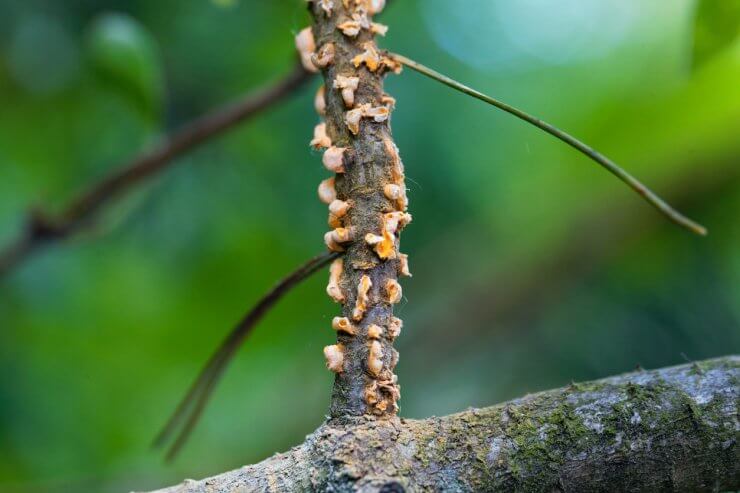
Powdery mildew on gooseberry
Like all food crops, gooseberry bushes are susceptible to fungal diseases. Your best weapons against these are choosing disease-resistant plants, keeping your bushes pruned to provide adequate air circulation, and watering the roots of the plant only, ideally early in the morning.
This is especially important, as there are no fungicides approved for home use for many diseases.
Watering: Make sure your gooseberry bushes get about an inch of water every 10 days or so. If you don’t get enough rain, make a trip out with the garden hose. Do not over-water your bushes; gooseberry bushes hate having wet feet! Soggy soil invites disease.
Mulch: Mulch can help with water retention—but be vigilant and check for insect or fungal activity.
Other best practices include:
- Buy healthy, disease-free plants from reputable sources
- Plant in sites with good drainage; if planting in open ground, choose a higher spot for better drainage and protection from cold air
- Proper winterization
- Proper pruning and fertilizing in the spring
Common gooseberry diseases

Pine blister rust
White pine blister rust is not a serious disease in gooseberries. North American white pine species are susceptible to white pine blister rust, and gooseberry bushes can serve as what’s called an “alternate host” for the fungus. When the fungus transfers from the gooseberry to the white pine (or any five-needle pine), the tree becomes infected. The best way to prevent this unhealthy relationship is to keep the two types of plants apart. As we mentioned in the Introduction to Gooseberries, some states have banned growing gooseberries in areas where white pines grow. Check with your local extension center to see if you need a permit to grow gooseberries, or if they’re not welcome in your neck of the woods at all.
Beyond the white pine blister rust risk, here are some of the usual culprits that might infest your gooseberry bushes. Remember, it’s important to remove diseased fruit, flowers, and leaves to prevent the spread of disease once it’s found its way onto your bush. In general, gooseberry bushes have been bred to be disease-resistant. But that doesn’t mean they won’t get infected.
Anthracnose
Cause: Fungus
Symptoms:
- leaves turn yellow at the tips, eventually turning brown all around
- browned, dying leaves
- dark, sunken lesions on fruit and/or stems
How it Spreads:
- spores spread by rain, splashing water
- wind
Treatment:
- remove all infected parts
- clear ground of leaf and twig litter
- apply liquid copper fungicide to reduce recurrence
Prevention:
- prune bush to provide good air circulation and access to sunlight
- provide proper water and fertilizer
Leaf Spot/Septoria Leaf Spot
Cause: Fungus
Symptoms:
- starts as a small spot and spreads
- spots get bigger; center area becomes light with a brown border
- small black specks appear on the surface of the light spot; these specks contain the fungal spores
- diseased leaves fall off
How it Spreads:
- splashing water (rain, irrigation) disturbs spores
- wind
Treatment:
- destroy infected fruits
- prune low-hanging branches to provide more clearance
Prevention:
- homemade fungicides
Powdery Mildew (American)
Cause: Fungus
Symptoms:
- white, powdery patches on branches, leaves, and berries
- whitish growth can cover large portions of the plant
- older infections look like a tan or reddish-brown felt covering; these contain spores
- heavy mildew infections can stunt a plant’s growth and cause early leaf-fall
How it Spreads:
- splashing water (rain, irrigation) disturbs and disperses spores
- wind
Treatment:
- remove and destroy infected plant material immediately
Prevention:
- liquid copper fungicide; if necessary, sulfur-based fungicide
- plant disease-resistant varieties
- increase air flow through bushes
- check bushes daily
- remove plant debris
Which diseases have you had to handle on your gooseberry bushes? Please tell us how you prevent and treat diseases. If you spot other symptoms on your gooseberry bushes that are not mentioned here, contact your local extension center or garden center for a consult—and please let us know what you found.


 Previous
Previous

